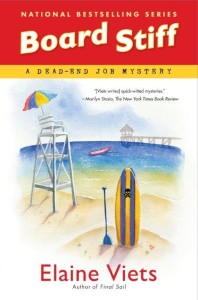By Elaine Viets
The first chapter is the hardest – at least for me.
In one page, I have to catch the reader’s attention, set the scene, and introduce the main characters.
But I can’t overdo it. Too many characters, and my first chapter has “crowded room syndrome.” The plot can’t move forward and readers lose track of everyone. Also, a mystery has to pass the three-second test: That’s how long bookstore customers supposedly linger over the first page before they decide to buy it or put it back.
I’ll spare you the whining, pacing, and time wasting it took to start “Board Stiff,” my new Dead-End Job hardcover. Here’s the condensed version.
“Board Stiff” is the ultimate beach book.
I wrote about the cutthroat competition for tourist dollars on Florida beaches. I was inspired by a newspaper story about companies that rented paddleboards, surf boards and other beach toys and sabotaged their competitors. In my book, sabotage naturally became murder.
Standup paddleboarding is the hot sport.
In “Board Stiff,” Sunny Jim Sundusky believes someone is destroying his paddleboard rental business.
I started the chapter with this quote:
“They’re trying to kill me,” Sunny Jim Sundusky said. “They nearly succeeded in March, but I’m a tough old buzzard. I survived. They almost got me in April, but I escaped again.” That’s a grabber, I decided. But who’s Sunny Jim talking to? And why? Most important, where are they? Some novels have snappy openings, but leave the characters floating in space for pages. I made sure Sunny Jim was securely grounded in the second paragraph:
Helen Hawthorne and her husband, Phil Sagemont, sat across from Sunny Jim in their black-and-chrome chairs in the Coronado Investigations office. Sunny Jim sat in the yellow client chair, looking anything but sunny. Now I’d introduced the three principals: Private eyes Helen and Phil, and this Sunny Jim character.
The Dead-End Job mysteries are told from Helen’s point of view. Here’s her take on Sunny Jim:
Sun-dried was more like it, Helen thought, as she studied him. His face was red leather. His blond hair was dyed and flash-fried in a crinkly permanent. But he did look tough.
Helen has more to say more about Sunny Jim’s looks, but I needed to get on with the story. Why is he in their office?
“They’re gonna keep coming after me until they stop me for good,” he said. “That’s why I wanna hire you two. I hear you’re the best private eyes in South Florida.” I let Sunny Jim say the couple is the best in South Florida – and also pin the chapter to a place on the map.
The response is typical Helen and Phil, and reveals something about the PI pair. Phil knows they’re the best detective agency in South Florida. He takes Jim’s praise as his due. Helen is more modest.
“We were lucky to get good publicity,” Helen said.
“That wasn’t luck,” Phil said. “That was good detecting.”
“That’s what I need,” Sunny Jim said. “Detecting. I want you to stop them before they stop me – permanently.” Helen is the observant one. She watches Sunny Jim while he talks, and gives us a better picture of their potential client.
He stabbed his chest with a brown callused hand, right in the smiling sun on his yellow SUNNY JIM’S STAND-UP PADDLEBOARD RENTAL T-shirt. His arms and legs were roped with muscle and his chest was a solid slab.
Helen had seen enough steroid hardbodies to know that Jim built that beef the old-fashioned way. She thought he was attractive in a dated disco style, except he was too young to have caught the seventies’ disco fever. She guessed his age on the shady side of thirty-five. My novel’s first page ends with Sunny Jim’s demand for action:
“So, you gonna save my business or not?” Jim’s eyes were hidden behind expensive shades – Floridians rarely had naked eyes – but his chin jutted in a challenge.
I patted myself on the back and kept on writing.

What did my editor think? She wanted one change: “How can Sunny Jim call himself old if he’s around thirty-five?” she asked.
Oh, right. I changed that line to read:
“They nearly succeeded in March, but I’m one tough buzzard.
“Board Stiff” was launched.
*******************************************
Check out the “Board Stiff” book trailer: http://tinyurl.com/ljgyzen
Buy it as an e-book and hardcover from bn.com: http://tinyurl.com/mvzbtfz
Buy it on Amazon: http://tinyurl.com/kqdd8dj




Beginnings are difficult…we all want that “hook” to be perfect. I also struggle with endings (both climaxes and denouements) and titles. For the latter, I usually have a working title, and then sweat over ending and title together. A title is worse than a blurb. I fail to understand the rash of one word titles…they just don’t catch my attention.
I’d rather write a whole novel than a title, Steven. Worse, titles are chosen by a committee — I come up with a list of titles, my editor goes over them and makes her suggestions, then the sales department looks at them. I’m so relieved when I finally get a title, the rest of the book seems easy.
My May 2014 book title is one word, but it does describe the action — “Catnapped!” My editor came up with that one, bless her.
Elaine, I usually have the first page/chapter written in my head before I sit down to begin drafting the manuscript. That’s because it’s the part of the book I’ve concentrated on since the concept of the story was first born. But I tend to tweak the first page what seems line a hundred times before I type “the end”. It’s like the old adage about making a first impression. You only get one shot.
And the more I worry about that one shot, the more I tweak.
It’s funny, Elaine, but I find beginnings easy. It’s almost always how I get and nurture the idea. The hard part for me is the ending. I want to leave the reader satisfied that the long journey through the book has been worth it. But I love writing openings. I do an exercise where I write just opening paragraphs. Many of them are fantastic….the difficulty is in choosing which ones to put a book after!
BTW, I like your opening. Dialogue is a great way to do it because it means you’re immediately in a scene. Nicely done.
Thanks. I’ve read some good descriptive openings, but tend to go with dialogue.
Mystery Scene magazine has a regular feature called “The Hook” with intriguing first lines.
I really love beginnings. I think about beginnings constantly. Usually in images: a lone car speeds across the desert in the night, twilight glimmers in the west, stars come out, darkness envelops the earth.
Sunny Jim sounds like my kinda guy, Elaine. Check out Elaine’s great website. Is that “Life’s a mystery” bib available in adult sizes? And speaking of wonderful South Florida, check out “The Prince of Paradise” by John Glatt. I was “there” in 1958.
You think in cinematic terms, Jim — always a good beginning.
Chapter one is hard for me, too. Part of it is psychological, the long hard dark road ahead sort of thing. But I think I let myself get too hung up on the “grab em by the throat” thriller trope. (which is patently false).
Consequently, I often start with chapter two and GO BACK and write chapter one when I have a better feel for things. But then again, I often write the LAST chapter early in the book so I might just be weird.
As for your chapter, Elaine, it is a splendid object lesson in how to SHOW instead of TELL. You convey tons of info and even backstory through snappy dialog and Helen’s observation. Good stuff!
Interesting way to get around the chapter 1 dilemma, Kris. Certainly avoids dragging out the old baggage and rummaging through it — “this is too hard . . .the critics didn’t like my last opening . . .”
I like the opening. But one of those “rules” I keep hearing is that you should never start a novel with dialogue. I personally don’t mind it when I read it. But I seem to be hung up on it in my own writing. Is it something a new writer might get blasted for?
Ron, that is a dumb “rule” that great writers have never heard of. Like Michael Connelly. Heck, like Mark Twain. As I stated above, beginning with dialogue gets us RIGHT INTO A SCENE, which is something a lot of writers following this non-existent “rule” have trouble with.
Start talking.
Go for the dialogue, Ron. As James said, better writers than me (I? there’s never a copyeditor around when you need one) use it. Just make sure your readers who who’s talking, why and where.
The hard part is two thirds of the way through. Your initial enthusiasm has turned into the realization that this is work, tyou’ve got this brilliant conclusion that you’re not quite sure how to get to, your characters have started doing things you didn’t expect them to (if you’ve created real, believable characters they tend to go off on their own and surprise you) and your carefully thought-out plot suddenly is developing holes like an old dinghy. Two-thirds of the way through, that’s where it takes guts and determination to find the ending.
Ah, the sagging middle. Yep, that’s another problem for another blog.
The few first lines of a book are critical, especially with the free sample feature on Amazon. Beginnings are the toughest part of the book for me, too. You did a great job setting up the tone, location, characters, and element of suspense all on page one.
That Amazon sample has become the new book test, Nancy. Now we can get rejected at 3 AM, as well as 9 AM to 10 PM.
My original chapter ones all end up becoming chapter twos or threes by the time I’m done. As far as envisioning the story, sometimes I picture the big event that blows the doors open, sometimes I picture only an individual or an object that gets me wondering what it’s about. In my current WIP, I pictured the whole burrito in one gigantic serving. The whole thing flooded in so fast I could barely contain it and had to buy two extra brain storage bladders to attach to my ears so the stuff wouldn’t spill out and stain the carpet will all that violent prose and gushy romance stuff, not to mention the wild animals and smelly stuff from the forest.
It’s really hard to get those stains out of the carpet too. I am still dealing with the dried blood and ground in baklava from my last book…that flaky philo dough really adheres to shag rugs.
LOL, Basil. What mouth watering prose.